- Home
- David McCullough
The Great Bridge: The Epic Story of the Building of the Brooklyn Bridge
The Great Bridge: The Epic Story of the Building of the Brooklyn Bridge Read online
Also by David McCullough
JOHN ADAMS
BRAVE COMPANIONS
TRUMAN
MORNINGS ON HORSEBACK
THE PATH BETWEEN THE SEAS
THE GREAT BRIDGE
THE JOHNSTOWN FLOOD
SIMON & SCHUSTER
Rockefeller Center
1230 Avenue of the Americas
New York, New York 10020
Copyright © 1972 by David McCullough
All rights reserved, including the right of reproduction
in whole or in part in any form.
The quotation from My Life and Loves, by Frank Harris, is
reprinted by permission of Grove Press, Inc.; copyright 1925 by
Frank Harris, © 1953 by Nellie Harris, © 1963 by Arthur Leonard
Ross as executor of the Frank Harris Estate.
SIMON & SCHUSTER and colophon are
registered trademarks of Simon & Schuster, Inc.
The Library of Congress has cataloged the hardcover edition as follows:
McCullough, David G.
The great bridge.
New York: Simon and Schuster, 1972.
Bibliography: p.
Includes index.
1. Brooklyn Bridge (New York, N.Y.)
I. Title.
TG25.N53M32 624.5’5’097471 72-081823
ISBN-13: 978-0-7432-1831-3
ISBN-10: 0-7432-1831-0
Visit us on the World Wide Web:
http://www.SimonSays.com
For my mother and father
Contents
AUTHOR'S NOTE
PART ONE
1. The Plan
2. Man of Iron
3. The Genuine Language of America
4. Father and Son
5. Brooklyn
6. The Proper Person to See
7. The Chief Engineer
PART TWO
8. All According to Plan
9. Down in the Caisson
10. Fire
11. The Past Catches Up
12. How Natural, Right, and Proper
13. The Mysterious Disorder
14. The Heroic Mode
PART THREE
15. At the Halfway Mark
16. Spirits of ’76
17. A Perfect Pandemonium
18. Number 8, Birmingham Gauge
19. The Gigantic Spinning Machine
20. Wire Fraud
21. Emily
22. The Man in the Window
23. And Yet the Bridge Is Beautiful
24. The People’s Day
EPILOGUE
APPENDIX
NOTES
BIBLIOGRAPHY
INDEX
AUTHOR’S NOTE
WHEN I began this book I was setting out to do something that had not been done before. I wanted to tell the story of the most famous bridge in the world and in the context of the age from which it sprang. The Brooklyn Bridge has been photographed, painted, engraved, embroidered, analyzed as a work of art and as a cultural symbol; it has been the subject of a dozen or more magazine articles and one famous epic poem; it has been talked about and praised more it would seem than anything ever built by Americans. But a book telling the full story of how it came to be, the engineering involved, the politics, the difficulties encountered, the heroism of its builders, the impact it had on the lives and imaginations of ordinary people, a book that would treat this important historical event as a rare human achievement, had not been written and such was my goal.
I was also greatly interested in the Roeblings, about whom quite a little had been written, but not for some time or from the kind of research I had in mind. Moreover, a good deal of legend about the Roeblings—father, son, and daughter-in-law—still persisted, along with considerable confusion. It seemed to me that the story of these remarkable people deserved serious study. It is an extraordinary story, to say the least, not only in human terms, but in what it reveals about America in the late nineteenth century, a time that has not been altogether appreciated for what it was.
And beyond that I had a particular interest in the city of Brooklyn itself, having spent part of my life there, when my wife and I were first married, in a house just down the street from where Washington and Emily Roebling once lived.
But early in my research another objective emerged. It became clear that this, to a large degree, was to be Washington Roebling’s book. There was, for example, that day in the library at the Rensselaer Polytechnic Institute when I unlocked a large storage closet to see for the first time shelf after shelf of his notebooks, scrapbooks, photographs, letters, blueprints, old newspapers he had saved, even the front-door knocker to his house in Brooklyn. No one knew then what all was in the collection. There were boxes of his papers that had not been opened in years, bundles of letters that so far as I could tell had been examined by nobody. The excitement of the moment can be imagined. The contents of the collection, plus those in another large collection at Rutgers University, both of which are described in the Bibliography, were such that they often left me with the odd feeling of actually having known the Chief Engineer of the bridge. He was not only the book’s principal character, he was the author’s main personal contact with that distant day and age. So it has also been my aim to convey, with all the historical accuracy possible, just what manner of man this was who built the Brooklyn Bridge, who achieved so much against such staggering odds, and who asked so little.
I am not an engineer and the technical side of the research has often been slow going for me. But though I have written the book for the general reader, I have not bypassed the technical side. If I could make it clear enough that I could understand it, if it was interesting to me, then my hope was that it would be both clear and interesting to the reader.
During my years of research and writing I have been extremely fortunate in the assistance I have received from many people and I should like to express to them my abiding gratitude. For their kindnesses and help I wish to thank the librarians at both Rutgers and Rensselaer and in particular Miss Irene K. Lionikis of the Rutgers Library and Mrs. Orlyn LaBrake and Mrs. Adrienne Grenfell of the library at Rensselaer. Herbert R. Hands of the American Society of Civil Engineers, David Plowden, Dr. Milton Mazer, Dr. Roy Korson, Professor of Pathology at the University of Vermont, W. H. Pearson, Sidney W. Davidson, J. Robert Maguire, Charlotte La Rue of the Museum of the City of New York, Regina M. Kellerman, William S. Goodwin, Allan R. Talbot, John Talbot, and Jack Schiff, the engineer in charge of New York’s East River bridges, each contributed to the research. And Dr. Paul Gugliotta of New York, architect and engineer, said some things over lunch one day years ago that started me thinking about doing such a book and later very kindly walked the bridge with me and answered many questions.
I am especially indebted to Robert M. Vogel, Curator, Division of Mechanical and Civil Engineering at the Smithsonian Institution, to John A. Kouwenhoven, authority on New York City history and on James B. Eads, to Nomer Gray, bridge engineer, who has made his own extensive technical studies of the bridge, and to Charlton Ogburn, author and friend. Each of them read the manuscript and offered numerous critical suggestions, but any errors in fact or judgment that may appear in the book are entirely my own.
I would like to acknowledge, too, the contribution of three members of the Roebling family: Mr. Joseph M. Roebling of Trenton and Mr. F. W. Roebling, also of Trenton, who gave of their time to talk with me about their forebears, and Mrs. James L. Elston of Fayetteville, Arkansas, who let me borrow an old family scrapbook.
I am grateful for the research facilities and assistance offered by the staffs of the following: the Trenton Free Public Library; the Carnegie Library, Pittsburgh; the Brooklyn Public Library; the Long Island Historical Society, Brooklyn, and particularly to Mr. John H. Lindenbusch, its executive director; the Newport Historical Society, Newport, Rhode Island; the Library of Congress; the New York Historical Society; the New York Public Library; the Engineering Societies Library, New York; the Middlebury College Library, Middlebury, Vermont; the Baker Library, Dartmouth College; the Putnam County Historical Society and the Julia Butterfield Memorial Library at Cold Spring, New York; and the Butler County Library, Butler, Pennsylvania.
I wish also to acknowledge my indebtedness to two valued friends who are no longer living—to Conrad Richter, for his encouragement and example, and to Clarence A. Barnes, my father-in-law, who was born on Willow Street on Brooklyn Heights, when the bridge was still unfinished, and who could talk better than anyone I knew about times gone by.
Lastly I would like to express my thanks to Paul R. Reynolds, who provides steady encouragement and sound advice; to Peter Schwed, Publisher of Simon and Schuster, who had faith in the idea from the start; to Jo Anne Lessard, who typed the manuscript; to my children, for their confidence and optimism; and to my wife, Rosalee, who helped more than anyone.
—DAVID MCCULLOUGH
PART ONE
1
The Plan
The shapes arise!
—Walt Whitman
THEY MET at his request on at least six different occasions, beginning in February 1869. With everyone present, there were just nine in all—the seven distinguished consultants he had selected; his oldest son, Colonel Washington Roebling, who kept the minutes; and himself, the intense, enigmatic John Augustus Roebling, wealthy wire rope manufacturer of Trenton, New Jersey, and builder of unprecedented suspension bridges.
They met at the Brooklyn Gas Light Company on Fulton Street, where the new Bridge Company had been conducting its affairs until regular offices could be arranged for. They gathered about the big plans and drawings he had on display, listening attentively as he talked and asking a great many questions. They studied his preliminary surveys and the map upon which he had drawn a strong red line cutting across the East River, indicating exactly where he intended to put the crowning work of his career.
The consultants were his idea. In view of “the magnitude of the undertaking and the large interests connected therewith,” he had written, it was “only right” that his plans be “subjected to the careful scrutiny” of a board of experts. He did not want their advice or opinions, only their sanction. If everything went as he wanted and expected, they would approve his plan without reservation. They would announce that in their considered professional opinion his bridge was perfectly possible. They would put an end to the rumors, silence the critics, satisfy every last stockholder that he knew what he was about, and he could at last get on with his work.
To achieve his purpose, to wind up with an endorsement no one could challenge, or at least no one who counted for anything professionally, he had picked men of impeccable reputation. None had a failure or black mark to his name. All were sound, practical builders themselves, men not given to offhand endorsements or to overstatement. With few exceptions, each had done his own share of pioneering at one time or other, and so theoretically ought still to be sympathetic to the untried. They were, in fact, about as eminent a body of civil engineers as could have been assembled then, and seen all together, with their display of white whiskers, their expansive shirt fronts and firm handshakes, they must have appeared amply qualified to pass judgment on just about anything. The fee for their services was to be a thousand dollars each, which was exactly a thousand dollars more than Roebling himself had received for all his own efforts thus far.
Chairman of the group was the sociable Horatio Allen, whose great girth, gleaming bald head, and Benjamin Franklin spectacles gave him the look of a character from Dickens. He fancied capes and silver-handled walking sticks and probably considered his professional standing second only to that of Roebling, which was hardly so. But like Roebling he had done well in manufacturing—in his case, with New York’s Novelty Iron Works—and forty years before he had made some history driving the first locomotive in America, the Stourbridge Lion, all alone and before a big crowd, on a test run at Honesdale, Pennsylvania. He had also, in the time since, been one of the principal engineers for New York’s Croton Aqueduct and so was sometimes referred to in biographical sketches as “the man who turned the water on.”
Then there was Colonel Julius Adams of Brooklyn, a former Army engineer, who was usually described as an expert on sewer construction, and who, in truth, was not quite in the same league as the others. He had, however, a number of influential friends in Brooklyn and for years he had been dabbling with designs for an East River bridge of his own. For a while it had even looked as though he might be given the chance to build it. When Roebling’s proposal was first made public, he had been among those to voice sharp skepticism. That he had been included as a consultant at this stage was taken by some as a sign that Roebling was not entirely the political innocent he was reputed to be.
William Jarvis McAlpine, of Stockbridge, Massachusetts, was the president of the American Society of Civil Engineers. Kindly, genial, widely respected, he had built the enormous dry dock at the Brooklyn Navy Yard, the Albany Water Works, and a fair number of bridges. He was also the proud possessor of what must have been the most elaborate jowl whiskers in the profession and he was the one man in the group, the two Roeblings included, who had had any firsthand experience working with compressed-air foundations, or caissons, as they were called, which, in this particular case, was regarded as an attribute of major proportions.
Probably the best-known figure among them, however, was Benjamin Henry Latrobe of Baltimore, who had the face of a bank clerk, but whose endorsement alone would perhaps have been enough to settle the whole issue. He was the son and namesake of the famous English-born architect picked by Jefferson to design or remodel much of Washington, and who rebuilt the Capitol after it was burned by the British during the War of 1812. He had laid out most of the B&O Railroad and had been in charge of building a number of exceptional bridges in Maryland and Virginia.
And finally there was John J. Serrell, the only builder of suspension bridges in the group except for the Roeblings; J. Dutton Steele, chief engineer of the Reading Railroad; and James Pugh Kirkwood, a rather mournful-looking Scotsman who was an authority on hydraulics, among other things, and who, in 1848, in northeastern Pennsylvania, had built the beautiful stone-arched Starrucca Viaduct, then the most costly railroad bridge in the world.
There is no way of knowing what thoughts passed through the minds of such men as they first looked over Roebling’s drawings and listened to him talk. But it is also hard to imagine any of them remaining unimpressed for very long, for all their collective experience or their own considerable accomplishments or any professional jealousies there may have been. Nor does it seem likely that any of them failed to sense the historic nature of the moment. Roebling was the recognized giant of their profession, a lesser-Leonardo he would be called, and even on paper his bridge was clearly one of the monumental works of the age. To an engineer especially that would have been obvious.
A bridge over the East River, joining the cities of New York and Brooklyn, had been talked about for nearly as long as anyone could recall. According to the best history of Brooklyn ever written, a three-volume work by a medical doctor named Henry R. Stiles, Volume II of which appeared that same year of 1869, the idea for a bridge was exactly as old as the century, the first serious proposal having been recorded in Brooklyn in 1800. Stiles wrote that an old notation, found in a scrapbook, referred to an unnamed “gentleman of acknowledged abilities and good sense” who had a plan for a bridge that would take just two years to build. Probably the gentleman was Thomas Pope of New York, an altogether fa
scinating character, a carpenter and landscape gardener by trade, who had designed what he called his “Flying Pendent Lever Bridge,” an invention, as he saw it, available in all sizes and suitable for any site. His bridge to Brooklyn was to soar some two hundred feet over the water, with a tremendous cantilever fashioned entirely of wood, like “a rainbow rising on the shore,” he said in the little book he published in 1811. Thomas Pope’s “Rainbow Bridge” was never attempted, however, and fortunately so, for it would not have worked. But his vision of a heroic, monumental East River bridge persisted. Year after year others were proposed. Chain bridges, wire bridges, a bridge a hundred feet wide, were recommended by one engineer or another. “New York and Brooklyn must be united,” Horace Greeley declared in the Tribune in 1849, while in Brooklyn a street running down to the river was confidently christened Bridge Street.

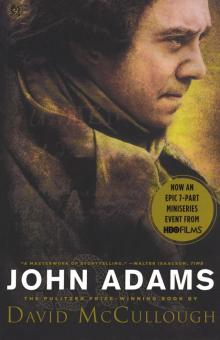 John Adams
John Adams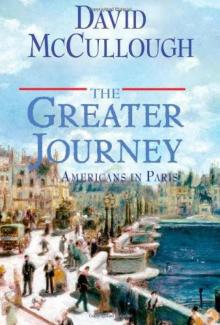 The Greater Journey: Americans in Paris
The Greater Journey: Americans in Paris 1776
1776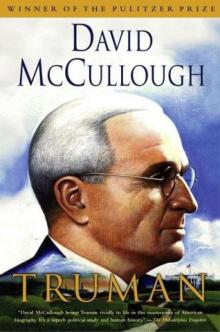 Truman
Truman The Pioneers
The Pioneers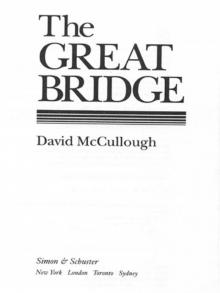 The Great Bridge: The Epic Story of the Building of the Brooklyn Bridge
The Great Bridge: The Epic Story of the Building of the Brooklyn Bridge The American Spirit
The American Spirit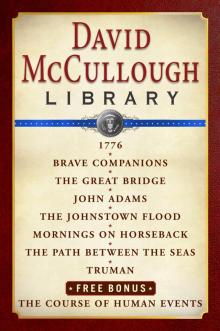 David McCullough Library E-book Box Set
David McCullough Library E-book Box Set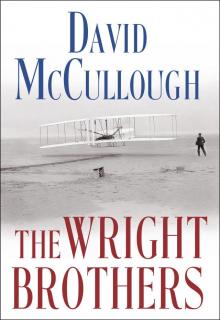 The Wright Brothers
The Wright Brothers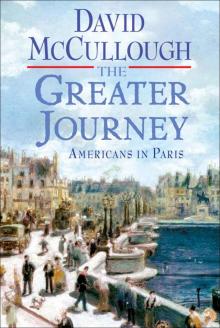 The Greater Journey
The Greater Journey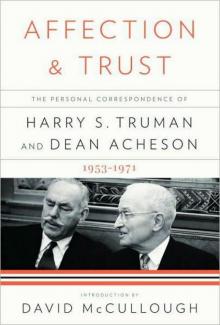 Affection and Trust: The Personal Correspondence of Harry S. Truman and Dean Acheson, 1953-1971
Affection and Trust: The Personal Correspondence of Harry S. Truman and Dean Acheson, 1953-1971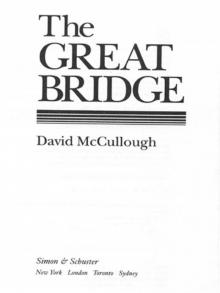 The Great Bridge
The Great Bridge